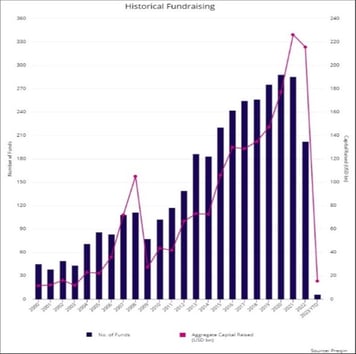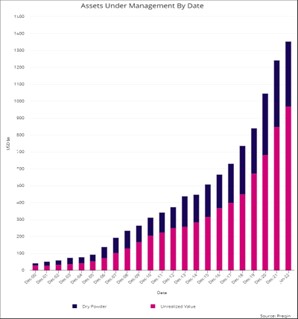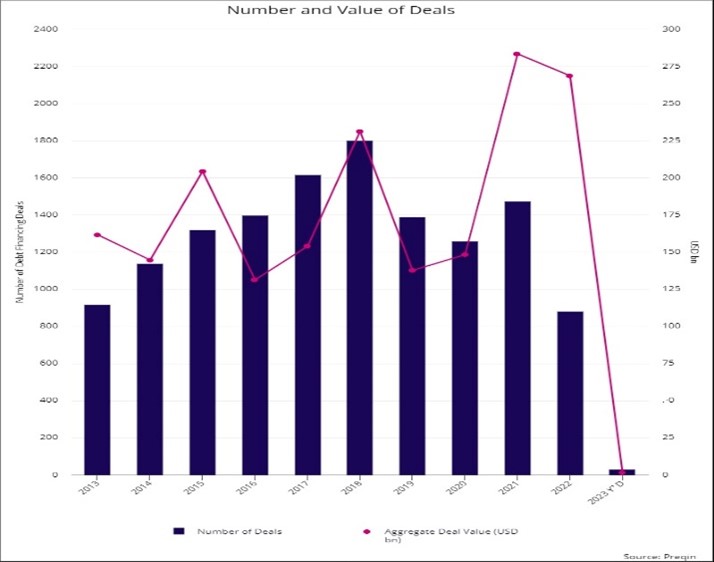Vidrio Financial takes a look into the private credit space, how allocators are rebalancing towards this asset class, and how we are assisting these strategies.
By: David Barry, Director of Marketing, Vidrio Financial
There’s no ignoring the volatility that we are seeing in the financial markets whether it’s from inflation, geopolitical unrest, debt ceiling panics or other market forces. At the same time, institutional investors are rebalancing portfolios and moving away from the 60/40 portfolio split in favor of 50% equities/30% bonds, and 20% alternatives. Within this 20%, private credit continues to pick up steam as we move deeper into 2023.
Why Private Credit?
Private credit is a way for businesses to raise capital outside the traditional banking system, where institutional investors lend money to a company in exchange for interest payments, imposing covenants or collateral that secures the loan. Allocators can get direct exposure by lending themselves or investing in funds that pursue private credit strategies. This area of financing has gained traction over the years as many businesses were left underserved through bank consolidation and lending pullbacks. The combination of traditional lenders pulling back and new private credit providers aggressively raising institutional cash has resulted in the latter quickly taking market share from syndicated lenders. Many believe that private credit lenders are now steering the boat when it comes to private credit strategies with expected yields growing to at least 12% in 2023.
In a recent article published from efinancialcareers.com, insights gained from the London School of Economics’ (LSE) Alternative Investment Conference points to a large amount of ‘hung debt’ which banks took on to finance M&A activities. Due to this higher-than-normal inventory at these banks, many are looking to sell that debt and private credit investors seem to be first in line. There is still caution to investors looking to expand their careers in this space as write-downs on private credit funds could show the true pain of the sector in the future.
At Vidrio Financial we are helping our clients by monitoring their private credit allocations, at the underlying loan level, via the collection and aggregation of detailed loan level data.
Over the last several years the number of private credit funds has grown substantially alongside the amount of capital being raised, (source: Preqin Historical Fundraising).


(source: Preqin Research 2023)
In the second chart (at the right), AUM by date, we can see the amount of capital that has been allocated to private credit funds has also increased from 2019-2022. We also see that the amount dry powder has decreased slightly as managers find attractive opportunities to deploy more capital. A recent press release by Cresset Partners seems to back that trend with the launch of Cresset Partners Private Credit Fund. In that release, they mentioned the specific market volatility that investors are facing today and how that presents a more favorable story for the deployment of capital into private credit.
The Number and Value Equation
Through this final chart we can observe that the number of private credit deals between 2021 and 2022 has dropped by ~40%, with the value also decreasing to $268.6bn from $283.4bn. What the chart doesn’t layer into the analysis is the average deal size, which we observed increasing from $1.4bn in 2021 to $2.1bn in 2022.

Vidrio Financial Perspective
We continue to see a lot of interest in the private credit space both on the allocator/investor front as well as on the fund side where we see numerous hedge funds and private equity firms launching private credit businesses and diving into the private credit sector. It remains to be seen how interest rates will affect the sector in the short term, but it looks like investors are optimistic on the space in the long run.
Vidrio Financial integrates private credit strategies using our state-of-the-art technology and advanced analytics (IRR’s, Investment Multiples, Standard Deviation, Sharpe Ratios, VaR, Exposure Aggregation) focused on allocation, performance, attribution and exposure. Loan level data for private credit is enriched for specific loan types, spread, net leverage, maturity, and financial metrics, (EBITA, CAPEX and LTV). This helps allocators manage and monitor this growing asset class under a single platform rather than a multitude of home-grown solutions. Vidrio clients recognize the strength of our single system as they can view their multi-asset class data through added analytics, charts, tables, and reports, all customized to meet the needs of each investment team.






